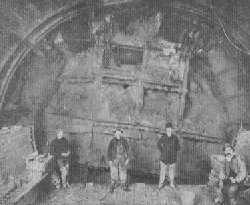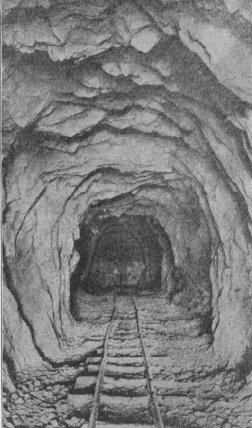|
While America possesses several ingeniously constructed bores in the earth for means of transit, it does not claim a reputation for great tunnels. The greatest length of any tunnel in the United States is the Hoosac tunnel, four and three-quarter miles long. Most others do not much exceed a mile. lt consumed 21 years to build the Hoosac tunnel and cost $15,000,000. Of late years, rapid transit in the great cities has become such a serious problem, that its solution, in some cases, has lain in the construction of underground railways, so that the city streets may be relieved of their great congestion. For years, the engineers of the world have been at work to devise the best methods to construct these tunnels. London has been successful already, and now possesses three great underground railway systems, besides having in projection several others. The systems cost over $200,000,000 and were completed only after scores of contracts had been made and broken. The mileage of these systems is about 150 miles.
Chicago is discussing at present the feasibility of subways for its crowded street car traffic. Already there is a bore constructed many feet below its principal thoroughfares, almost large enough to admit cars. This tunnel is to accommodate conduits for compressed air tubes for the transmission of mail and express packages, and for telegraph, telephone, and electric light wires. It will probably be only a short time before the right will be given to widen this tunnel, and street cars will be run through it. Of city tunnels, that which the Paris Metropolitan Railway built for its three transverse lines, all of which, one above the other, run under the Grand Opera House in Paris, is among the most notable. The stage portion of the "Opera" is 12 or 14 stories high, four or five of which are underground, and one wonders how much of a subterranean journey a passenger will be obliged to take to board a train on the nethermost of the transverse lines, that running from Autenil to La Madeline. The Alps are most notable for great tunnels. There is the Arlberg, six and a half miles long; the Mount Cenis, seven and a quarter miles; St. Gothard, nine and a quarter miles, and Simplon, which will be 12¼. miles long when the builders get through the mountain. About 1855 when the people of the Alpine country tired of packing their goods by mules over the mountains, they resolved upon a tunnel. Work was begun, in 1857, with pick axes and crowbars. The work was done both in France and Italy, but so slow was the method that from two to eight feet a day, only, could be bored. After driving at the rocks for five years, a Frenchman, named Sommeiller, invented a drill that could bore a hole in 20 minutes which men could not dig in two hours. After that the work went on at a greater pace, and the tunnel was finished in 1871.
Another great bore through the Alps is the Arlberg. This is about as long as Mt. Cenis,—six and a half miles,—yet it took only about one-fourth of the time to build it. It was begun in 1880, and progressed at the rate of 27¾ feet a day, finishing in 1884. This tunnel facilitates trade in Austro-Hungary by connecting the province of Von Arlberg, through the Arl mountain, with the rest of the Austrian Tyrol. Prince Torlonia built one of the earliest, successful, European tunnels, between 1854 and 1876 over the route used by Emperor Claudius, of Rome. The old emperor is said to have used 30,000 laborers, for 11 years, on this tunnel, to drain Lake Fucino, which at that time covered 48,000 acres of fertile land. Soon after it was first completed, however, it fell into ruins. Prince Torlonia rescued it at an expense of $4,800,000. It is three and a half miles long, and in some places, runs 400 feet below the surface of the ground. Mt. Cenis Tunnel is situated 16 miles from Mt. Cenis between the province of Turin in Italy and the Department of La Savoie, in France, at the junction of the Graian with the Cottian Alps. Its total length is 40,084 feet or 7.6 miles. The elevation of the southern entrance above the sea is 4,237 feet; of the northern entrance, 3,802 feet; of the terminating point, 4,247 feet. The tunnel is broad enough for two double lines of tracks. It was begun August 31, 1857, completed December 26, 1870, and cost $1,500,000. The first tunnel built in the United States was that on the Union Canal, constructed between 1818 and 1821. It was 450 feet wide, 20 feet high and 80 feet wide, but has since been made an open cut. Twenty months' building put through a noted subwater tunnel for the Grand Trunk Railway under the St. Clair river. This bore is 6,050 feet long, and cost $3,000,000. Many of the western railways of the United States have tunnels that they may well be proud of, although generally in this country, tunnels are avoided where possible by making detours. The Great Northern Railway has a tunnel in Montana over 6,000 feet long and Mullen's tunnel, on the route of the Northern Pacific Railroad, strikes through the Continental Divide of the Rocky Mountains. At Idaho Springs, Colorado, is being constructed, to facilitate mining operations, a tunnel which starts at the base of the mountain, and will penetrate the range at a depth of many thousand feet below the mines, which are worked far up toward the summit. Its course lies through about 86 of the best known and most productive gold and silver veins in Colorado. As to the Simplon Tunnel, the longest in the world, The "Engineering Record" says: "The northern terminus of the tunnel is readily reached by railway from Geneva. Its purpose is to save about seventy-seven kilometers in the railway distance between Paris and Milan, as compared with the Mont Cenis and St. Gothard routes. This saving is between seven and eight per cent of the total distance, and to effect it will involve the expenditure of 69,500,000 francs. "The total length of the main tunnel will be 19,770 kilometers; elevation of first portal, 686 meters; second portal, 634 meters; summit height of tunnel, 704 meters; summit height of mountain, 2,840 meters; surcharge of tunnel, 2,135 meters; maximum rock temperature, cent. degrees, 40.0." 1Tunnel extends three miles under Lake Michigan to Intake. this picture is taken 00 feet undrground by flashlight. The construction of the tunnel is made by means of compressed air. Return to text. SCIENCE THE BENEFACTOR OF THE FARMER |

